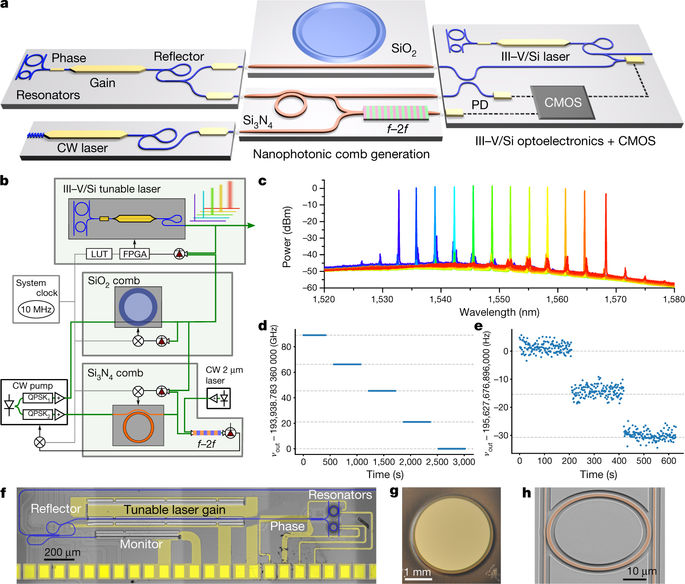Our official English website, www.x-mol.net, welcomes your
feedback! (Note: you will need to create a separate account there.)
An optical-frequency synthesizer using integrated photonics
Nature ( IF 50.5 ) Pub Date : 2018-04-25 , DOI: 10.1038/s41586-018-0065-7 Daryl T. Spencer , Tara Drake , Travis C. Briles , Jordan Stone , Laura C. Sinclair , Connor Fredrick , Qing Li , Daron Westly , B. Robert Ilic , Aaron Bluestone , Nicolas Volet , Tin Komljenovic , Lin Chang , Seung Hoon Lee , Dong Yoon Oh , Myoung-Gyun Suh , Ki Youl Yang , Martin H. P. Pfeiffer , Tobias J. Kippenberg , Erik Norberg , Luke Theogarajan , Kerry Vahala , Nathan R. Newbury , Kartik Srinivasan , John E. Bowers , Scott A. Diddams , Scott B. Papp
Nature ( IF 50.5 ) Pub Date : 2018-04-25 , DOI: 10.1038/s41586-018-0065-7 Daryl T. Spencer , Tara Drake , Travis C. Briles , Jordan Stone , Laura C. Sinclair , Connor Fredrick , Qing Li , Daron Westly , B. Robert Ilic , Aaron Bluestone , Nicolas Volet , Tin Komljenovic , Lin Chang , Seung Hoon Lee , Dong Yoon Oh , Myoung-Gyun Suh , Ki Youl Yang , Martin H. P. Pfeiffer , Tobias J. Kippenberg , Erik Norberg , Luke Theogarajan , Kerry Vahala , Nathan R. Newbury , Kartik Srinivasan , John E. Bowers , Scott A. Diddams , Scott B. Papp

|
Optical-frequency synthesizers, which generate frequency-stable light from a single microwave-frequency reference, are revolutionizing ultrafast science and metrology, but their size, power requirement and cost need to be reduced if they are to be more widely used. Integrated-photonics microchips can be used in high-coherence applications, such as data transmission1, highly optimized physical sensors2 and harnessing quantum states3, to lower cost and increase efficiency and portability. Here we describe a method for synthesizing the absolute frequency of a lightwave signal, using integrated photonics to create a phase-coherent microwave-to-optical link. We use a heterogeneously integrated III–V/silicon tunable laser, which is guided by nonlinear frequency combs fabricated on separate silicon chips and pumped by off-chip lasers. The laser frequency output of our optical-frequency synthesizer can be programmed by a microwave clock across 4 terahertz near 1,550 nanometres (the telecommunications C-band) with 1 hertz resolution. Our measurements verify that the output of the synthesizer is exceptionally stable across this region (synthesis error of 7.7 × 10−15 or below). Any application of an optical-frequency source could benefit from the high-precision optical synthesis presented here. Leveraging high-volume semiconductor processing built around advanced materials could allow such low-cost, low-power and compact integrated-photonics devices to be widely used.An optical-frequency synthesizer based on stabilized frequency combs has been developed utilizing chip-scale devices as key components, in a move towards using integrated photonics technology for ultrafast science and metrology.
中文翻译:

使用集成光子学的光频合成器
光频合成器从单个微波频率参考产生频率稳定的光,正在彻底改变超快科学和计量学,但如果要更广泛地使用它们,它们的尺寸、功率要求和成本需要降低。集成光子微芯片可用于高相干性应用,例如数据传输 1、高度优化的物理传感器 2 和利用量子态 3,以降低成本并提高效率和便携性。在这里,我们描述了一种合成光波信号绝对频率的方法,使用集成光子学来创建相位相干的微波到光链路。我们使用异构集成的 III-V/硅可调谐激光器,该激光器由在单独的硅芯片上制造的非线性频率梳引导,并由片外激光器泵浦。我们的光频合成器的激光频率输出可以通过 4 太赫兹频率接近 1,550 纳米(电信 C 波段)的微波时钟进行编程,分辨率为 1 赫兹。我们的测量证实合成器的输出在该区域内异常稳定(合成误差为 7.7 × 10−15 或更低)。光频率源的任何应用都可以从这里介绍的高精度光学合成中受益。利用围绕先进材料构建的大容量半导体加工,可以广泛使用这种低成本、低功耗和紧凑的集成光子器件。关键零件,
更新日期:2018-04-25
中文翻译:

使用集成光子学的光频合成器
光频合成器从单个微波频率参考产生频率稳定的光,正在彻底改变超快科学和计量学,但如果要更广泛地使用它们,它们的尺寸、功率要求和成本需要降低。集成光子微芯片可用于高相干性应用,例如数据传输 1、高度优化的物理传感器 2 和利用量子态 3,以降低成本并提高效率和便携性。在这里,我们描述了一种合成光波信号绝对频率的方法,使用集成光子学来创建相位相干的微波到光链路。我们使用异构集成的 III-V/硅可调谐激光器,该激光器由在单独的硅芯片上制造的非线性频率梳引导,并由片外激光器泵浦。我们的光频合成器的激光频率输出可以通过 4 太赫兹频率接近 1,550 纳米(电信 C 波段)的微波时钟进行编程,分辨率为 1 赫兹。我们的测量证实合成器的输出在该区域内异常稳定(合成误差为 7.7 × 10−15 或更低)。光频率源的任何应用都可以从这里介绍的高精度光学合成中受益。利用围绕先进材料构建的大容量半导体加工,可以广泛使用这种低成本、低功耗和紧凑的集成光子器件。关键零件,











































 京公网安备 11010802027423号
京公网安备 11010802027423号